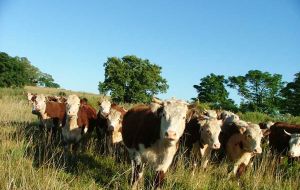MercoPress. South Atlantic News Agency
FAO Food Price index falls in 20014 on large cereals' supplies and record stocks
 Cereals prices during 2014 dropped 12.5% from the previous year, buoyed by forecasts of record production and ample inventories.
Cereals prices during 2014 dropped 12.5% from the previous year, buoyed by forecasts of record production and ample inventories.  The FAO Meat Price Index declined in December but the index is near its monthly all-time highs, and on a full-year basis rose 8.1% in 2014 from 2013
The FAO Meat Price Index declined in December but the index is near its monthly all-time highs, and on a full-year basis rose 8.1% in 2014 from 2013 FAO's monthly Food Price Index declined in December after three months of stability. Continued large supplies and record stocks combined with a stronger U.S. dollar and falling oil prices contributed to the decline, which helped bring the 2014 overall Food Price Index down 3.7%.
The December Food Price Index averaged 188.6 points, a drop of 1.7 percent from November, led down by sugar and palm oil. For the whole of 2014, the Food Price Index averaged 202 points, down 3.7% from 2013, marking the third consecutive annual decline.
This year-on-year drop came despite FAO's sub-index for meat rising to an all-time high annual average of 199 points, up 8.1% from 2013. Cereals, by contrast, dropped 12.5% from the previous year, buoyed by forecasts of record production and ample inventories.
FAO's Food Price Index is a trade-weighted index that tracks prices of five major food commodity groups on international markets. It aggregates price sub-indices of cereals, meat, dairy products, vegetable oils and sugar. Four of those indices fell in 2014 and are at, or close to, their lowest levels in five years.
The FAO Cereal Price Index averaged 183.9 points in December, up 0.4% from November as wheat prices rose on the back of worries that Russia may restrict exports. However, the increase was capped by the stronger U.S. dollar. Moreover, rice prices fell markedly amid abundant export supplies.
The FAO Vegetable Oil Price Index average declined by 2.4% to a five-year low of 161 points in December, due mainly to depressed demand for palm oil as a biodiesel feedstock, itself linked to falling global oil prices.
The FAO Dairy Price Index declined by 2.3% to 174 points, its lowest level since late 2009, as slowing imports by China and Russia left abundant export supplies for international markets. Price declines were greatest for milk powders, butter and cheese.
The FAO Meat Price Index also declined in December, down 1.9% from the previous month, as a stronger U.S. dollar curbed price quotations for beef and mutton from Oceania and pork from Europe. However, at 204 points, this index is near its monthly all-time highs, and on a full-year basis rose 8.1% in 2014 from 2013, the only commodity group to post higher average prices over the year.
The FAO Sugar Price Index dropped 4.8% to 219 points in December, largely because of ample supplies in major producing countries such as Brazil. Falling crude oil prices, which reduce demand for sugar crops to be converted into ethanol, also weighed on international sugar quotations in December.
Lower crude oil prices spelled bearish price trends for commodities that can be used for bio-fuels, notably sugar but also palm oil, which has the largest weight inside the vegetable oils index, said FAO senior economist Abdolreza Abbassian. “Ample supplies aside, the drop in oil prices obviously makes ethanol production less attractive,” he said.




Top Comments
Disclaimer & comment rulesCommenting for this story is now closed.
If you have a Facebook account, become a fan and comment on our Facebook Page!